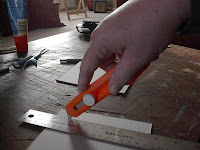
The process (except for the cutting) is easy. Close pins and office clips help secure the signatures until the glue dries. I ran out of gauze that I lay over the glue to give extra security to the binding, so I used cotton lace. Improvising is one of my favorite skills.

As the glue dries, I begin measuring and cutting the book board. Counting fractions and worrying about sharp edges, calculating numbers and drawing straight lines, shake my steady hand. "Measure twice, cut once", says every good carpenter, but does any of it sink in to my eye-hand coordination? No. Yet, I keep trying to stay straight and avoid the crooked lines. The longest part of making a journal is the cutting. Even with a metal ruler, a very sharp blade, I still feel crooked edges creeping into my book board. But I keep trying. Someday, I'll stop seeing crooked and everything will straighten out.

The outside book board is covered with a heavy weight paper. I found a textured white sheet of paper at Reuel's Art Supply.

Since I wanted to make a Valentine's journal, I chose the white paper to cover the book board and a red scrap book paper for the inside. One side of the scrap book paper is glued to the book board to give a finished look to the inside.

The finished project fits nicely in a gift box and it a perfect present to give a loved one to record their thoughts, or to hold precious photographs.














